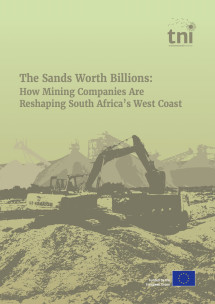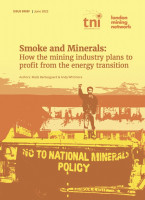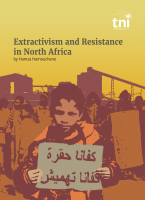The sands worth billions How mining companies are reshaping South Africa’s West Coast
Regions
Unveiling the intricate web of the South African mining industry, this report delves into the century-old economic powerhouse, exploring its multifaceted impact on communities and the environment. Focusing on mineral sands, it dissects corporate strategies and unravels the historical context that shapes contemporary mining dynamics. The report adopts an analytical lens, examining the three circuits of capital—productive, commodity, and money—revealing the industry's intricate workings. From the burgeoning 'gold fever' to environmental repercussions and the symbiotic relationship between mining magnates and the state, each section sheds light on critical facets. Culminating in inspiring narratives of social movements, the report advocates for a deeper understanding of capitalism's role, concluding with a thought-provoking query on the potential impact of a People’s Tribunal in the pursuit of justice.

Downloads
Authors
Introduction
The concern is… how the mining people cooperates with government and municipalities and get clearance to do their stuff but we know nothing about that. We just see a lorry coming… okey there they gonna work” – Oslan Tuter, Papendorp
I would like to send a whole army of people around the world [to] bring investors here… funding is available [and] we will be able to attract a great deal of funding” – President Cyril Ramaphosa, 30 July 2021
The mining industry is among the biggest contributors to the South African economy. The industry has flourished for more than a century, even as it has dispossessed local communities, caused environmental harm and contributed to the climate crisis. Mining corporations and the state continue to pursue new frontiers of mining, and people from the affected communities keep fighting against these trends. This report aims to provide affected people, social movements and organisations engaged in mining struggles with a deeper understanding of corporate strategies in contemporary capitalism. Hopefully, the report can offer a useful contribution to the struggles for social, economic and environmental justice in the context of mining in South Africa and beyond.
This report looks specifically at mineral sands. It unpacks the types of minerals the sands contain, what they are used for and who derives profits from them. It does so by looking into the corporations own publications, tracking their involvement in politics and their intermingling with the state. It also relies on media reports and academic articles to supplement these primary source documents. Particular attention is given to one of the largest corporations involved in mineral sands globally, Tronox Holdings plc (hereafter Tronox). Furthermore, the report looks into the history of mining in South Africa for the purpose of demonstrating some of the persisting patterns of capitalism over time, as the economics and politics of contemporary mining cannot be fully understood without looking into the past.
The report aims to provide readers with an analytical approach to understanding mining corporations. Building on the work of people who have written extensively about mining and other extractive industries, the intention is to look at the strategies corporations make use of in three interconnected circuits of capital: the circuit of productive capital (the site of extraction in mining); the circuit of commodity capital (the value chain of minerals); and the circuit of money capital (financiers investing in mining). This approach makes it evident that it is important, if not essential, for political struggle to look beyond the ‘site of extraction’ (the circuit of production).
The first section, the sands worth billions, provides a basic overview of the valuable minerals contained in the sands found on the West Coast of South Africa, what these minerals are used for, and which corporations are active in this region. This is followed by three sections on each of the three circuits of capital.
The section on productive capital focusses on the site of exploitation of mineral resources, through intensification and extensification of mining. Corporations invest in new technologies to enhance extraction while reducing costs — they intensify production. At the same time, they also invest in new mining areas through prospecting in new areas, expanding the mining within areas where mining rights are already obtained or by acquiring mining rights from other corporations. This is referred to as extensification. Both intensification and extensification are corporate strategies applied in the circuit of productive capital. In the next section, on commodity capital, we focus on the process of selling the commodity on the market at the highest possible price as fast as possible. Corporations seek to maximise profits by improving logistical arrangement for getting the commodity to the market. In doing so, they make use of different strategies. This is followed by the section on money capital, which analyses the way corporations depend on investments to expand mining activities and position themselves as leaders in a competitive industry. In this circuit of capital, corporations strategise to secure investments from actors possessing money capital.
Following this elaboration of the three circuits of capital, the High stakes: The ‘gold fever’ of mineral sands section extends the analysis to show the ways political and economic interest in the sands continues to grow. The section exposes some of the new mining players (new prospecting companies) and highlights the centrality of land rights in the struggle against mining.
Even mining companies are willing to acknowledge that mining impacts the natural environment. The section on impacts on the environment presents evidence of the different environmental consequences resulting from mining, while questioning the extent, or sufficiency, of scientific or empirical evidence in the context of minerals sands mining. It is proposed for actors involved in assessing the the impacts of mining to put stronger emphasis on, among other approaches, participatory action research.
The following section on the revolving door exposes how mining magnates mingle with the state and vice versa. By highlighting examples from South Africa’s long mining history, the section exposes how the capitalists become politicians or use their economic power to influence politics. It also shows how politicians and senior government officials use their positions to transition into the business of mining, through political reforms (e.g. Black Economic Empowerment) or corruption, to tap into the profits derived from mining.
The final section sheds light on the daunting task of winning struggles for justice. It describes three particular struggles waged by social movements in South Africa over the past two decades — namely the human rights struggle of small-scale fishers, the Xolobeni anti-mining struggle, and the Treatment Action Campaign’s (TAC) struggle for AIDS treatment. The aim is to highlight, as a source of inspiration, the various political strategies applied by social movements.
The conclusion explains the extent that mining in South Africa is and has always been embedded in capitalism. Many of the same practices we see today date back to the colonial era, continued during Apartheid and persist in more sophisticated forms under contemporary democracy. This points at the centrality of developing a deeper understanding of how capitalism functions: How the corporations strategise and make profits, and how the state depends upon and promotes mining. It finishes with a reminder of past successful struggles and a question for the reader: Could a People’s Tribunal trigger a new turning point in the struggle for justice?


